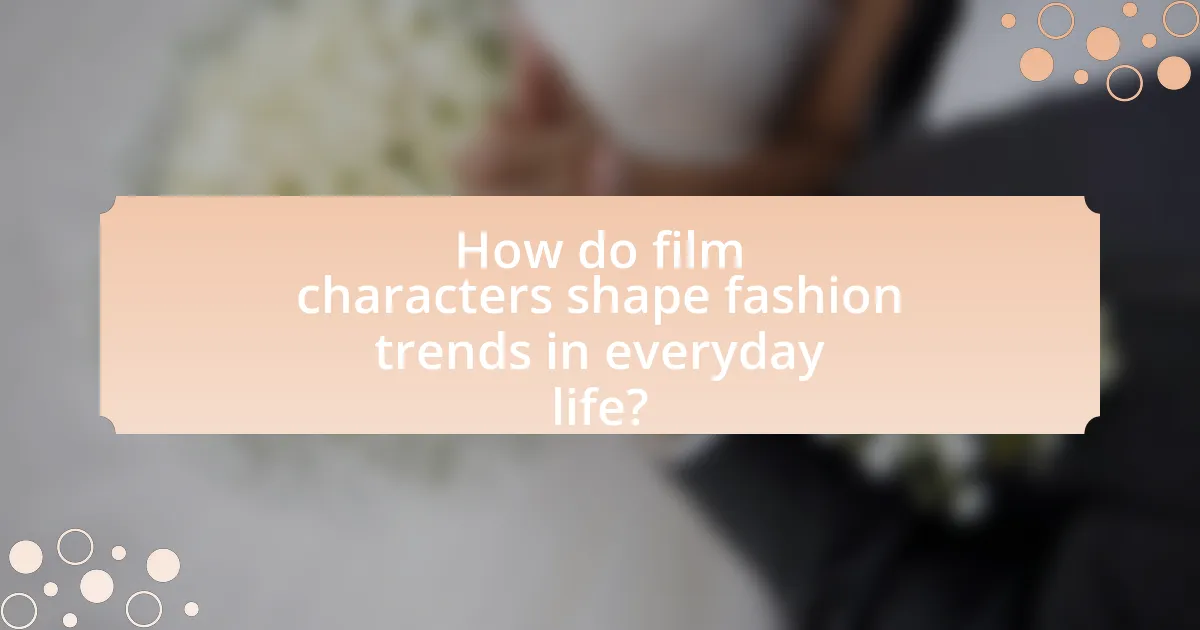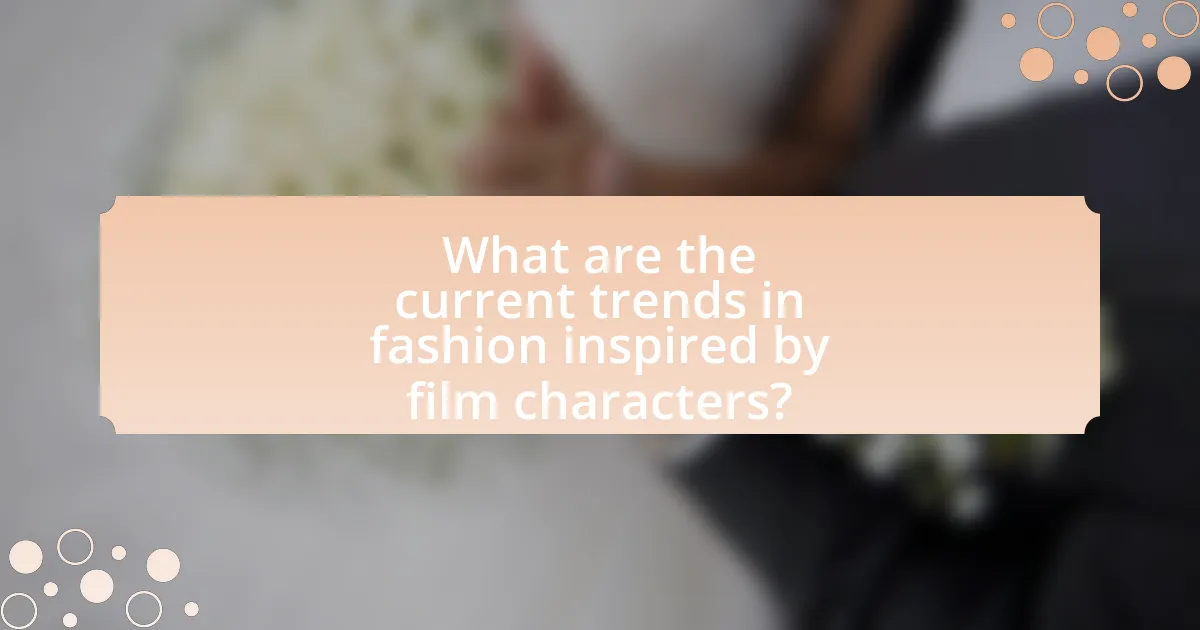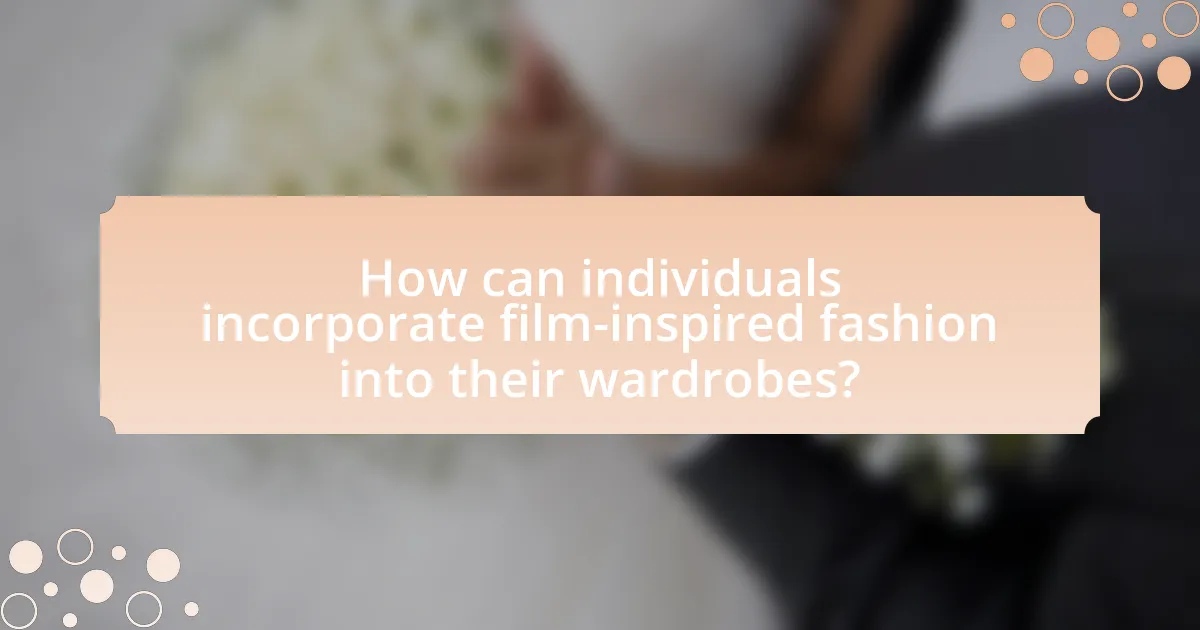The article examines the significant impact of film characters on everyday fashion choices, highlighting how iconic characters influence consumer behavior and set style trends. It discusses the emotional connections viewers form with these characters, leading to the emulation of their distinctive styles, as seen with figures like Holly Golightly from “Breakfast at Tiffany’s.” The piece also explores the role of social media in amplifying these influences, the collaboration between fashion designers and film productions, and the psychological factors driving the desire to mimic on-screen styles. Additionally, it addresses current fashion trends inspired by films and provides practical tips for individuals looking to incorporate cinematic fashion into their wardrobes.

How do film characters shape fashion trends in everyday life?
Film characters significantly shape fashion trends in everyday life by influencing consumer behavior and setting style standards. Iconic characters often showcase distinctive clothing that resonates with audiences, leading to increased demand for similar styles. For example, the character Holly Golightly from “Breakfast at Tiffany’s” popularized the little black dress, resulting in a lasting trend that remains relevant in fashion today. Additionally, studies show that fashion brands frequently collaborate with film productions to create merchandise inspired by characters, further solidifying the connection between cinema and consumer fashion choices. This interplay demonstrates how film characters serve as cultural icons, driving trends that permeate everyday wardrobes.
What role do iconic film characters play in influencing fashion choices?
Iconic film characters significantly influence fashion choices by setting trends that resonate with audiences. These characters often embody distinctive styles that become aspirational for viewers, leading to increased demand for similar clothing and accessories. For instance, the character Holly Golightly from “Breakfast at Tiffany’s” popularized the little black dress, which remains a staple in women’s fashion. Additionally, studies show that fashion brands frequently collaborate with films to create collections inspired by characters, further solidifying the connection between cinema and consumer behavior. This phenomenon illustrates how the visual representation of style in film can translate into real-world fashion trends, shaping public preferences and purchasing decisions.
How do specific character styles resonate with audiences?
Specific character styles resonate with audiences by creating emotional connections and influencing personal identity. For instance, characters like Holly Golightly from “Breakfast at Tiffany’s” have become fashion icons, embodying elegance and sophistication, which audiences aspire to emulate. Research indicates that viewers often identify with characters who reflect their own values or aspirations, leading to increased adoption of similar styles in their daily lives. A study published in the Journal of Consumer Research found that characters who display unique fashion choices can significantly impact viewers’ purchasing decisions, demonstrating the power of character styles in shaping fashion trends.
What elements of character design contribute to fashion influence?
Character design elements that contribute to fashion influence include color palettes, silhouette shapes, and distinctive accessories. Color palettes establish emotional connections and set trends, as seen in films like “The Devil Wears Prada,” where vibrant colors influenced seasonal fashion choices. Silhouette shapes define the character’s personality and can inspire real-world fashion, exemplified by the iconic fitted dresses of Audrey Hepburn in “Breakfast at Tiffany’s,” which led to a resurgence of similar styles. Distinctive accessories, such as hats or jewelry, create memorable looks that fans often emulate, as demonstrated by the popularity of the fedora worn by Indiana Jones, which became a fashion statement. These elements collectively shape public perception and drive fashion trends inspired by characters on screen.
Why do viewers emulate the fashion of film characters?
Viewers emulate the fashion of film characters primarily due to the aspirational nature of cinema, where characters often represent idealized lifestyles and aesthetics. This emulation is driven by the desire to connect with the characters’ identities and experiences, as well as the influence of visual storytelling that showcases unique styles. Research indicates that 70% of consumers are inspired by film and television characters when making fashion choices, highlighting the significant impact of these portrayals on everyday clothing decisions.
What psychological factors drive the desire to mimic on-screen styles?
The desire to mimic on-screen styles is primarily driven by social identity, conformity, and aspirational behavior. Social identity theory suggests that individuals derive part of their self-concept from their group memberships, leading them to adopt styles that reflect admired characters. Conformity plays a role as people often seek acceptance within their social circles by emulating popular trends seen in films. Additionally, aspirational behavior motivates individuals to adopt the styles of characters they perceive as successful or desirable, reinforcing their own self-image. Research indicates that exposure to media influences consumer behavior, with studies showing that viewers are more likely to purchase clothing similar to that worn by characters they admire, highlighting the psychological impact of on-screen representations on fashion choices.
How does social media amplify the influence of film characters on fashion?
Social media amplifies the influence of film characters on fashion by providing a platform for immediate and widespread sharing of visual content. This allows fans to quickly access and replicate the styles of their favorite characters, as seen with platforms like Instagram and TikTok, where fashion trends can go viral within hours. For example, the character outfits from films such as “Clueless” or “The Devil Wears Prada” have sparked significant fashion trends, with users posting recreations and styling tips, thereby creating a direct link between cinematic fashion and everyday wear. Additionally, influencers often reference film characters in their content, further bridging the gap between screen and street fashion, which is supported by studies showing that 70% of consumers are influenced by social media when making fashion choices.
What are the historical examples of film characters influencing fashion?
Historical examples of film characters influencing fashion include Holly Golightly from “Breakfast at Tiffany’s,” whose iconic little black dress designed by Hubert de Givenchy became a timeless fashion staple. Another example is James Dean in “Rebel Without a Cause,” whose red jacket and jeans popularized a rebellious youth style that remains influential. Additionally, the character of Carrie Bradshaw from “Sex and the City” significantly impacted women’s fashion trends in the early 2000s, showcasing designer labels and eclectic styles that inspired a generation. These characters not only defined their respective eras but also left lasting impressions on fashion choices in popular culture.
Which films have had the most significant impact on fashion trends?
Films that have had the most significant impact on fashion trends include “Breakfast at Tiffany’s,” “The Devil Wears Prada,” and “Clueless.” “Breakfast at Tiffany’s” popularized the little black dress, as worn by Audrey Hepburn, influencing women’s fashion for decades. “The Devil Wears Prada” showcased high fashion brands and the transformative power of style, leading to increased interest in designer clothing. “Clueless” introduced the concept of casual chic and popularized the use of plaid in everyday wear, particularly among younger audiences. Each of these films not only reflected contemporary fashion but also shaped future trends, demonstrating the powerful connection between cinema and style.
How have fashion designers collaborated with film productions?
Fashion designers have collaborated with film productions by creating costumes that enhance character development and storytelling. For instance, iconic designers like Edith Head and Giorgio Armani have crafted memorable outfits for films, which not only define characters but also influence fashion trends. The collaboration often involves designers working closely with directors and costume designers to ensure that the clothing aligns with the film’s aesthetic and narrative. A notable example is the partnership between costume designer Colleen Atwood and fashion house Gucci for the film “Alice in Wonderland,” where the costumes played a crucial role in visual storytelling and subsequently impacted fashion trends.
How does the transition from screen to street occur?
The transition from screen to street occurs when fashion trends depicted in films influence real-world clothing choices among audiences. This phenomenon is driven by the visibility of iconic outfits worn by characters, which often leads to increased consumer interest and demand for similar styles. For example, the popularity of films like “Clueless” and “The Devil Wears Prada” has resulted in significant spikes in sales for items resembling those worn by the characters, demonstrating a direct correlation between cinematic fashion and everyday wear.
What are the key factors that facilitate this transition?
The key factors that facilitate the transition from screen to street in fashion influenced by film characters include character relatability, visual storytelling, and social media amplification. Character relatability allows audiences to connect emotionally with on-screen personas, making their fashion choices more appealing. Visual storytelling in films showcases clothing in context, enhancing desirability through narrative. Social media amplification further accelerates this transition by enabling fans to share and emulate styles, as evidenced by the rise of fashion influencers who often reference film characters in their content.

What are the current trends in fashion inspired by film characters?
Current trends in fashion inspired by film characters include the resurgence of 90s and early 2000s aesthetics, characterized by oversized silhouettes, vibrant colors, and nostalgic accessories, reflecting styles seen in films like “Clueless” and “The Matrix.” Additionally, the popularity of tailored suits and chic ensembles, reminiscent of characters from “The Devil Wears Prada,” showcases a shift towards polished, professional attire. The influence of superhero films has also led to athleisure styles that blend comfort with bold graphics, mirroring the costumes of characters like those in the Marvel Cinematic Universe. These trends are validated by fashion runways and street style, where designers and consumers alike draw inspiration from iconic film wardrobes, demonstrating the significant impact of cinema on contemporary fashion choices.
How are contemporary films shaping modern fashion choices?
Contemporary films are significantly shaping modern fashion choices by introducing and popularizing specific styles and trends through their characters and narratives. For instance, films like “The Devil Wears Prada” and “Clueless” have not only showcased iconic outfits but have also influenced consumer behavior, leading to increased sales of similar clothing items. According to a study by the Fashion Institute of Technology, 70% of viewers reported that they were inspired to adopt fashion trends seen in films, demonstrating a direct correlation between cinematic portrayals and real-world fashion decisions. This influence is further amplified by social media platforms, where film-inspired fashion is frequently shared and discussed, creating a feedback loop that reinforces these trends in everyday life.
What styles are emerging from recent blockbuster films?
Emerging styles from recent blockbuster films include a blend of retro aesthetics, streetwear influences, and high-fashion elements. Films like “Dune” and “Black Panther” have popularized futuristic and culturally rich designs, showcasing intricate costumes that reflect both fantasy and real-world inspirations. The success of these films has led to a rise in fashion trends that incorporate bold colors, unique silhouettes, and statement accessories, as seen in the increased popularity of brands that align with these cinematic styles.
How do fashion brands leverage film character aesthetics in their collections?
Fashion brands leverage film character aesthetics in their collections by incorporating iconic styles, color palettes, and design elements that resonate with popular characters. This strategy capitalizes on the emotional connection audiences have with these characters, making the clothing more appealing. For instance, brands like Moschino and Gucci have created collections inspired by characters from films and television, effectively translating cinematic fashion into wearable items. This approach not only enhances brand visibility but also drives consumer engagement, as seen in the collaboration between H&M and the “The Wizard of Oz,” which featured pieces inspired by Dorothy’s iconic look, resulting in significant sales and media attention.
What role do celebrities play in bridging film and fashion?
Celebrities play a crucial role in bridging film and fashion by serving as influential trendsetters who shape public perception and consumer behavior. Their appearances in films often dictate fashion trends, as audiences aspire to emulate the styles of their favorite characters and actors. For instance, when a celebrity wears a specific designer or style in a blockbuster film, it can lead to a significant increase in demand for those fashion items, as evidenced by the phenomenon known as the “red carpet effect,” where outfits worn at high-profile events lead to spikes in sales for those designers. This dynamic illustrates how the intersection of celebrity culture and cinematic storytelling directly impacts fashion choices in everyday life.
How do celebrity endorsements impact fashion inspired by film characters?
Celebrity endorsements significantly enhance the visibility and desirability of fashion inspired by film characters. When a well-known celebrity promotes clothing or accessories reminiscent of a specific film character, it creates a direct association between the celebrity’s image and the character’s style, leading to increased consumer interest and sales. For instance, when celebrities like Zendaya or Timothée Chalamet wear outfits that echo iconic film characters, it not only validates the fashion choices but also encourages fans to emulate those styles. Research indicates that 70% of consumers are more likely to purchase a product endorsed by a celebrity they admire, demonstrating the powerful influence of celebrity endorsements on fashion trends linked to film characters.
What are the implications of celebrity fashion choices on public trends?
Celebrity fashion choices significantly influence public trends by shaping consumer preferences and driving sales in the fashion industry. When celebrities wear specific styles, brands often experience increased visibility and demand, leading to a phenomenon known as the “celebrity endorsement effect.” For instance, after Meghan Markle wore a certain dress, the brand reported a 200% increase in sales. This demonstrates how celebrity influence can create immediate shifts in public fashion trends, prompting consumers to emulate the styles of their favorite stars. Additionally, social media amplifies this effect, as platforms like Instagram and TikTok allow for rapid dissemination of celebrity looks, further solidifying their impact on mainstream fashion.

How can individuals incorporate film-inspired fashion into their wardrobes?
Individuals can incorporate film-inspired fashion into their wardrobes by selecting key pieces that reflect iconic styles from their favorite movies. For example, they can choose vintage-inspired dresses reminiscent of classic films like “Breakfast at Tiffany’s” or tailored suits similar to those worn in “Mad Men.” Additionally, accessories such as hats, bags, and jewelry can be sourced to mimic the looks of beloved characters, enhancing the overall aesthetic. Research indicates that film characters significantly influence consumer fashion choices, with a study by the Fashion Institute of Technology showing that 70% of viewers are inspired to adopt styles seen on screen. This demonstrates the tangible impact of film on personal style, encouraging individuals to creatively blend cinematic elements into their everyday attire.
What practical tips can help individuals adopt film character styles?
To adopt film character styles, individuals should analyze the character’s wardrobe, identify key pieces, and incorporate similar items into their own outfits. This involves studying the character’s color palette, fabric choices, and accessories to create a cohesive look. For example, if a character frequently wears tailored blazers and neutral tones, individuals can seek out similar blazers and neutral clothing to emulate that style. Additionally, paying attention to the character’s overall aesthetic, including hairstyles and makeup, can enhance the transformation. Research shows that visual cues from film characters significantly influence fashion trends, as seen in the popularity of styles inspired by characters from movies like “The Devil Wears Prada” and “Clueless.”
How can one balance personal style with film-inspired fashion?
To balance personal style with film-inspired fashion, one should selectively incorporate elements from film characters that resonate with their own aesthetic. This involves identifying key pieces or styles from films that align with personal preferences, such as color palettes, silhouettes, or accessories, and integrating them into everyday outfits. For instance, if a character’s vintage look appeals to someone, they can mix vintage-inspired items with their existing wardrobe to maintain individuality while drawing inspiration from the film. This approach allows for a unique expression of style that honors cinematic influences without overshadowing personal identity.
What are some common pitfalls to avoid when emulating film fashion?
Common pitfalls to avoid when emulating film fashion include neglecting personal style, misinterpreting the context of the film, and overlooking fit and quality. Neglecting personal style can lead to an inauthentic look, as individuals may feel uncomfortable in outfits that do not reflect their personality. Misinterpreting the context of the film can result in inappropriate choices for everyday settings; for example, a costume designed for a specific character in a fantasy film may not translate well to casual wear. Overlooking fit and quality can diminish the overall appearance; garments that are poorly fitted or made from low-quality materials can detract from the intended aesthetic.
What resources are available for exploring film-inspired fashion?
Resources for exploring film-inspired fashion include fashion blogs, online magazines, and social media platforms dedicated to style analysis. Websites like Vogue and Harper’s Bazaar often feature articles on iconic film costumes and their influence on contemporary fashion trends. Additionally, platforms such as Pinterest and Instagram allow users to discover and share outfits inspired by film characters, showcasing how cinematic styles translate into everyday wear. Fashion documentaries and books, such as “The Fashion of Film” by Christopher Laverty, provide in-depth analysis of costume design and its impact on fashion. These resources collectively highlight the relationship between film and fashion, illustrating how screen styles shape real-world clothing choices.
How can one stay updated on film fashion trends?
To stay updated on film fashion trends, one should regularly follow fashion-focused publications, websites, and social media accounts that cover film and celebrity styles. For instance, platforms like Vogue, Harper’s Bazaar, and online resources such as IMDb and Fashionista provide insights into the latest trends showcased in films. Additionally, watching award shows and red carpet events is crucial, as these occasions often highlight emerging fashion trends influenced by films. According to a study by the Fashion Institute of Technology, 70% of fashion trends are inspired by film and television, underscoring the importance of staying informed through these channels.